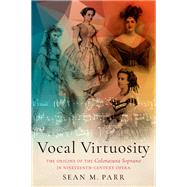
Vocal Virtuosity The Origins of the Coloratura Soprano in Nineteenth-Century Opera
by Parr, Sean M.Buy New
Rent Textbook
Rent Digital
Used Textbook
We're Sorry
Sold Out
How Marketplace Works:
- This item is offered by an independent seller and not shipped from our warehouse
- Item details like edition and cover design may differ from our description; see seller's comments before ordering.
- Sellers much confirm and ship within two business days; otherwise, the order will be cancelled and refunded.
- Marketplace purchases cannot be returned to eCampus.com. Contact the seller directly for inquiries; if no response within two days, contact customer service.
- Additional shipping costs apply to Marketplace purchases. Review shipping costs at checkout.
Summary
The central argument of Vocal Virtuosity challenges the historical commonplace that coloratura became an anachronism in nineteenth-century opera. Instead, the book demonstrates that melismas at mid-century were made modern. Coloratura became an increasingly marked musical gesture during the century with a correspondingly more specific dramaturgical function. In exploring this transformation, the book reveals the instigators of this change in vocal practice and examines the historical traces of Parisian singers who were the period's greatest exponents of vertiginous vocality as archetypes of the modern coloratura soprano. The book constructs the historical trajectory of coloratura as it became gendered the provenance of the female singer, while also considering what melismas can signify in operatic performance. As a whole, it argues that vocal virtuosity was a source of power for women, generating space for female authorship and creativity. In so doing, the book reclaims a place in history for the coloratura soprano.
Author Biography
Sean M. Parr is Associate Professor of Music at Saint Anselm College where he teaches music history and voice performance, as well as humanities courses in the core curriculum. With a PhD in Historical Musicology from Columbia University, his research interests focus on nineteenth-century opera, the operatic voice, dance, and gender. His work on singers and singing has been published in the Cambridge Opera Journal, 19th-Century Music, and Current Musicology. He also sings professionally as an operatic tenor and has taught voice for fifteen years.
An electronic version of this book is available through VitalSource.
This book is viewable on PC, Mac, iPhone, iPad, iPod Touch, and most smartphones.
By purchasing, you will be able to view this book online, as well as download it, for the chosen number of days.
Digital License
You are licensing a digital product for a set duration. Durations are set forth in the product description, with "Lifetime" typically meaning five (5) years of online access and permanent download to a supported device. All licenses are non-transferable.
More details can be found here.
A downloadable version of this book is available through the eCampus Reader or compatible Adobe readers.
Applications are available on iOS, Android, PC, Mac, and Windows Mobile platforms.
Please view the compatibility matrix prior to purchase.
